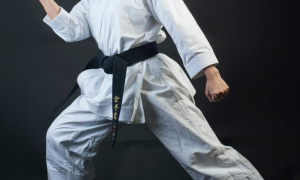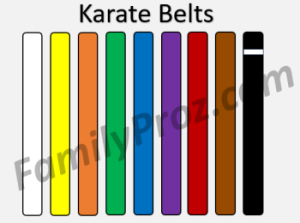
Karate and its belt system holds a deep-rooted tradition within the martial arts world. Standing as an iconic symbol, the karate belt order represents the levels of knowledge, skill, and personal growth attained by practitioners. In this comprehensive guide, we will delve into the captivating realm of karate belts, exploring their meaning and the journey they encompass.
Within the karate community, the colored belts serve as visual markers, signifying the degree of knowledge and proficiency achieved by practitioners. Each belt color represents a specific stage in the progression of a practitioner’s skills, denoting their growth and commitment to the art.
The karate ranking system comprises of 8 belts in various colors. These belts represent different levels of mastery, guiding practitioners on their journey of skill development. The belt colors, in order, are: white, yellow, orange, green, blue, purple, red, and brown.
Table of Contents
Toggle![]()
The History Behind Karate Belts and their order
In the past, karate had only three belt colors: white, brown, and black. However, everything changed in 1935 when Mikinosuke Kawaishi introduced the colored belt system to Europe while teaching judo in Paris. Kawaishi recognized the benefits of a visible belt system that consistently acknowledged and rewarded accomplishments. As a result, Western students progressed more swiftly.
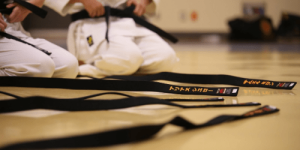
The concept of colored belts in karate emerged from Jigorō Kanō, the renowned founder of judo. At the turn of the 20th century, Kanō revolutionized martial arts by introducing colored belts. He drew inspiration from the ranking system in the game of go. This innovation allowed students to advance rapidly and provided fighters with a quick means of assessing opponents’ skill levels. It leveled the playing field in potential combat.
Initially, Kanō’s system featured blue, white, brown, and black belts. Over time, the palette expanded to include a wider range of colors. In 1924, Gichin Funakoshi embraced Kanō’s degree system in karate. This gave birth to the kyū and dan systems used worldwide in karate schools today. Unlike some other martial arts, such as Taekwondo, Shotokan karate practitioners progress through one of nine belts.
Understanding the significance of karate belts is crucial for martial arts students. It involves comprehending the purpose of the belt system, recognizing its evolution, and appreciating the dedication it represents.
![]()
The Belt System in Karate: Understanding Kyu and Dan Ranks
The belt system in karate consists of two sets: the kyū set for colored belts and the dan set for black belt degrees. It starts with a white belt and culminates in a 10th-degree black belt, denoting the highest mastery.
In the kyū system, which represents trainees without a rank, each color symbolizes a different level of proficiency. The ranks progress from higher numbers to lower ones, and each kyū is represented by a distinct belt color. The lowest kyū is typically the 8th rank, while the 1st kyū is the highest and is 1 grading away from a black belt.

Black belts are classified by dan ranks, starting from the 1st dan (first-degree black belt) and culminating in the 10th dan (tenth-degree black belt), associated with the grandmaster title. Those who hold a dan rank are referred to as yudansha.
The first five or six dan ranks are obtained through competitive examinations, while ranks 7 to 10 are honorary and often based on merit or age. Notably, the black belt signifies competence rather than mastery, indicating that the journey in karate continues beyond its attainment.
The kyu/dan grading system has been widely adopted in karate, influenced by the judo ranking system. This system emphasizes the progression of skill and competence rather than simply demonstrating mastery.
Different karate styles may vary in their belt colors and ranks, but the most common progression includes white, yellow, orange, green, blue, brown, and black. Four main karate styles exist, each with its own techniques, practices, and philosophies, but all adhere to a belt system for grading and measuring achievement.
Karate utilizes kyu rankings to indicate a student’s progress in technique, with “mudansha” representing practitioners at this stage. As karateka advance, they move down the kyu grades, with the 1st kyu (brown belt) being the most advanced student level.
Understanding the intricacies of the kyū and dan ranks in karate provides insight into the progression and achievements of practitioners. It is a testament to their dedication, skill, and continuous growth in this revered martial art.
![]()
Karate Belt Colors
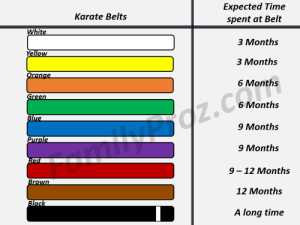
The kyū degrees usually start at 8th kyū (white belt) and progress to 1st kyū (brown belt) before attempting the black belt. Each kyū degree has a unique color. Striped belt variations are sometimes seen at the discretion of the school which further help distinguish progress.
There are typically eight colors for kyū degrees, although the order is usually fixed, some schools may have variations.
Karate belt colors ordered:
- White Belt
- Yellow Belt
- Orange Belt
- Green Belt
- Blue Belt
- Purple Belt
- Red Belt
- Brown Belt
- Black Belt
![]()
Karate Belts and their Meaning
White Belt Karate – 8th Kyu
![]()
The Karate journey begins with the White Belt, the lowest rank on the colored belt system. Representing purity and humility, the White Belt symbolizes a new beginning for every practitioner. Regardless of previous martial arts experience, everyone starts as a White Belt in their chosen Karate style. This stage is about embracing the art with an open mind and committing to learning and facing new challenges.
![]()
Yellow Belt Karate – 7th Kyu
![]()
After the White Belt comes the Yellow Belt, signifying the first rays of the rising sun in the practitioner’s mind. At this stage, basic techniques and blocks are learned, making the student an advanced beginner. While not yet proficient in advanced techniques, the Yellow Belt marks a significant milestone in the student’s journey, representing a willingness to explore and adapt to new changes and challenges.
![]()
Orange Belt Karate – 6th Kyu
![]()
Advancing from the Yellow Belt, the Orange Belt represents the spreading light of knowledge and skill. Students at this level develop more power in their strikes and begin to learn combinations, defensive maneuvers, and counters. The Orange Belt indicates that the practitioner is no longer a beginner and is progressing towards a deeper understanding of Karate’s principles.
![]()
Green Belt Karate – 5th Kyu
![]()
The Green Belt signifies the penetration of stems and roots, reaching for sunlight. At this stage, the practitioner’s skills are expanding, and they gain confidence in connecting combos, efficient defense, and even participating in friendly competitions. The Green Belt marks a significant advancement in their journey and reflects the growth of their Karate abilities.
![]()
Blue Belt Karate – 4th Kyu
![]()
As the student progresses, they enter the realm of the Blue Belt, representing the fruit-bearing stage of their growth. With a deeper understanding of their fighting style, practitioners at this level can transition smoothly from defense to offense, making them more versatile in combat situations. The Blue Belt is often a turning point where Karate starts to become a way of life for many dedicated practitioners.
![]()
Purple Belt Karate – 3rd Kyu
![]()
The Purple Belt signifies a heightened level of seriousness and commitment to the Karate journey. It marks the clear distinction between intermediate and advanced practitioners. At this stage, students demonstrate a strong determination to pursue their Karate career further and prepare for the upcoming belt levels with dedication and focus.
![]()
Red Belt Karate – 2nd Kyu
![]()
The Red Belt, a revered rank in Karate, comes after the Purple Belt but before the Brown Belt (although it is sometimes reserved for the highest ranks). It embodies the mastery of Karate skills, deep understanding of the art, and a strong commitment to the discipline. Red Belt practitioners demonstrate exceptional knowledge and competence, paving the way for their journey towards the prestigious Black Belt.
![]()
Brown Belt Karate – 1st Kyu
![]()
Reaching the Brown Belt level indicates the profoundness of the student’s knowledge and readiness for combat. Practitioners at this stage showcase refined techniques and a deeper understanding of the art. The Brown Belt is a significant achievement, representing a culmination of years of training and dedication.
![]()
Black Belt Karate
![]()
The Black Belt (1st Dan) is the pinnacle of achievement in Karate, representing mastery of the art. Earning this rank requires years of dedicated training, discipline, and a profound understanding of Karate’s techniques and principles. It marks the beginning of the Dan ranks, where practitioners continue to refine their skills and contribute to the Karate community as experienced mentors and leaders. Check out our guide on the Requirements for a Karate Black Belt.
![]()
Learn about other Martial Arts Belt systems in our articles on the:
![]()
Highest Belt in Karate
In Karate, the highest belt is typically the 10th Dan Black Belt. However it is not uncommon for a Red Belt to signify an even higher level of achievement and recognition. The Red Belt is sometimes reserved for exemplary masters of the art, who possess exceptional knowledge, competence, and contributions to the Karate community through teaching and reputation.
Karate Dan Levels (Black Belt Levels)
Dan ranks are considered advanced grades, this is where the real journey begins. A practitioner holding a dan level is called Yudansha.
Depending on the style, from the 6th or 7th dan, there is no further examination, the ranks are instead awarded by the headmaster, on an honorary basis.
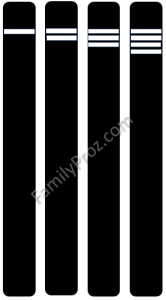
Karate Dan levels in order are:
- Shodan (1st Dan)
- Nidan (2nd Dan)
- Sandan (3rd Dan)
- Yondan (4th Dan)
- Godan (5th Dan)
- Rokudan (6th Dan)
- Nanadan (7th Dan)
- Hachidan (8th Dan)
- Kyudan (9th Dan)
- Judan (10th Dan)
Kyudan (9th Dan) and Judan (10th Dan) are honorary titles are awarded to very VERY special masters.
![]()
How long does it take to get each Karate belt
The time it takes to achieve each belt in Karate can vary based on individual dedication and training frequency. The table below shows an estimation as to how long one can expect to spend at each karate belt in order.

| Level | Karate Belt | Time To advance |
| 8th Kyu | White Belt | No set time |
| 7th Kyu | Yellow Belt | 3 Months as White Belt |
| 6th Kyu | Orange Belt | 3 Months as Yellow Belt |
| 5th Kyu | Green Belt | 3 Months as Orange Belt |
| 4th Kyu | Blue Belt | 6 Months as Green Belt |
| 3rd Kyu | Purple Belt | 6 Months as Blue Belt |
| 2nd Kyu | Brown Belt | 9 Months as Purple Belt |
| 1st Kyu | Red Belt | 12 Months as Brown Belt |
| Black Belt | Black Belt | 12 Months as Black Belt |
How long to achieve a Karate Black Belt?
On average, one could expect to achieve a Black Belt in approximately 4.5 years, assuming consistent training and successful completion of most gradings. However, it’s essential to remember that the journey to a Black Belt is unique for each individual, and some may take more or less time to reach this prestigious milestone.
![]()
How long does it take to get each Black Belt Dan in Karate?
The time it takes to achieve each Dan within the Black Belt system in Karate varies, with 10 Dans in total. To attain the 1st Dan, it typically takes 1 year of training. Subsequently, for the 2nd Dan, practitioners would require a total of 3 years (1 year for 1st Dan and 2 years for 2nd Dan). As a practitioner progresses through the Dans, each new rank demands one additional year of training beyond the previous Dan. Reaching the highest (10th) Dan Black Belt demands a minimum of 55 years of continuous training and mastery.

| Black Belt Dan | Min. Time spent at Dan | Total Time | Min. Age |
| 1st Dan | 1 year | 1 year | |
| 2nd Dan | 2 years | 3 years | |
| 3rd Dan | 3 years | 6 years | 18+ |
| 4th Dan | 4 years | 10 years | |
| 5th Dan | 5 years | 15 years | |
| 6th Dan | 6 years | 21 years | |
| 7th Dan | 7 years | 28 years | 50+ |
| 8th Dan | 8 years | 36 years | 60+ |
| 9th Dan | 9 years | 45 years | |
| 10th Dan | 10 years | 55 years |
![]()
Karate Belt stripes
Traditionally, Karate does not implement belt stripes, unlike some other martial arts like Taekwondo. However, to keep children engaged and motivated, some schools have introduced belt stripes for junior belts, serving as incremental markers of progress and achievement.
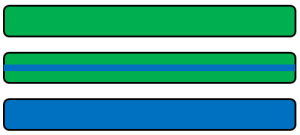
![]()
FAQ
What are all the belts in karate in order?
In Karate, the belt system progresses as follows: White Belt, Yellow Belt, Orange Belt, Green Belt, Blue Belt, Purple Belt, Red Belt, Brown Belt, and the prestigious Black Belt. The Black Belt Dan system includes: Shodan (1st Dan), Nidan (2nd Dan), Sandan (3rd Dan), Yondan (4th Dan), Godan (5th Dan), Rokudan (6th Dan), Nanadan (7th Dan), Hachidan (8th Dan), Kyudan (9th Dan), and Judan (10th Dan).
![]()
How many levels of karate belts are there?
In Karate, there are 9 levels of colored belts and 10 Dan degrees at the black belt level. The colored belts range from White to Brown, while the prestigious black belt system includes degrees known as Dans, starting from Shodan (1st Dan) and progressing up to Judan (10th Dan).
![]()
What is the hardest belt to get in karate?
The hardest belt to get in Karate is the Black Belt level. Achieving a Black Belt requires years of dedicated training, discipline, and a deep understanding of Karate’s techniques, principles, and philosophy.
Within the Black Belt level, there are degrees known as Dans, the highest dans are only awarded to individuals who have devoted decades of their life to teaching and spreading karate.
![]()
How many years does it take to get a black belt in karate?
The minimum time to achieve a Black Belt in Karate, assuming all gradings are passed early, is around 3.5 years. However, a more reasonable time-frame is approximately 5 years, requiring consistent dedication and training.
![]()
How to tie a karate belt?
Check out this video from Karate Dojo waKu.
![]()
Is there a Gold belt in karate?
No, there is no gold belt in Karate. The belt system in Karate typically progresses through a series of colored belts, such as White, Yellow, Orange, Green, Blue, Purple, Red, and Brown, leading up to the Black Belt (Dan) levels.
![]()


